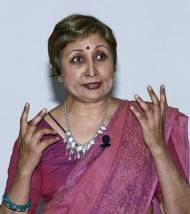 She sat in the only chair in the room, while we sat on the yellow benches adorned with the graffiti characteristic of a classroom. Watching Dr. Vayu Naidu, we understood why she is called a storyteller and credited with having coined the term ‘Performance Storytelling’. She is the author of Sita’s Ascent and Under the Banyan, and her latest book, The Subaltern’s Sari of Seeraivakkam, will be published in December. Dr. Naidu spent a week in our school, Vidya Vanam, and spoke to us about her influences, journey, and why she does what she does. Excerpts:
She sat in the only chair in the room, while we sat on the yellow benches adorned with the graffiti characteristic of a classroom. Watching Dr. Vayu Naidu, we understood why she is called a storyteller and credited with having coined the term ‘Performance Storytelling’. She is the author of Sita’s Ascent and Under the Banyan, and her latest book, The Subaltern’s Sari of Seeraivakkam, will be published in December. Dr. Naidu spent a week in our school, Vidya Vanam, and spoke to us about her influences, journey, and why she does what she does. Excerpts:
How did you get interested in storytelling?
I became interested in storytelling by accident. At the age of 27, I was in an accident and could not speak. I started theatre soon after and, for theatre, I needed to speak. My window into the world of speaking again came through storytelling. I had grown up listening to Ram Leela and Yakshaganaperformances. All these showed me how a good storyteller can connect the past with the present, enticing people to listen.
Do you tell only Indian stories?
No, I tell a lot of stories from around the world — African, Russian, Caribbean, and Indian — all sourced in different languages. Now, I write novels and use folk tales from around the world to influence my stories.
You use music and instruments in your storytelling. What does music add to your stories?
I often use Western contemporary and World music in my performances. Music creates landscapes. Sounds help the storyteller build interiors and exteriors of characters. It helps communicate emotion and tone. I like to think that music is an integral part of the storytelling experience.
What is the hardest thing about being a storyteller?
Physically, it is very tiring. The job comes with a lot of travelling. The hardest thing is to be calm and composed when one is angry, and even perform for a couple of hours in such a mindset. The skill of a good storyteller lies in taking an alien story to an unknown audience, and making them feel it as if it is their own.
What is your favourite story to tell and hear?
I absolutely love Ramayana to listen and to tell. I have spent time listening to the epic in a host of different languages including Punjabi, Bengali, Tamil, Gujarati and Telugu, and have constructed its narrative from the many retellings I have heard. Love, jealousy, hatred, loneliness, rejection, pride… they all find their place in this tale. One can never get bored of this epic and its plethora of storylines.
What, in your opinion, are the golden rules for storytelling?
The role of a storyteller is to really hold up the truth. Stories are a way of clarifying what is actually happening in life. It is essential, therefore, for the storyteller to be interested in the truth of the story. If I don’t know where I am in the story, how can I tell it to you? If I cannot feel Sita’s loss, what is the point of that narration? When I was training storytellers, I used to make my students sweep the classroom with me on the first day. The entire action of sweeping with a tall broom gives movement to the body and establishes a cadence in the speech. Within that exercise, I would ask them how and why they came to the class. It was a good way of finding out who was committed to the truth of a story, and who was only seeking to impress. The latter eventually stopped coming.
How has storytelling changed with the influence of technology?
I don’t think technology has disturbed storytelling. Today, there are ways of preserving stories with digitisation, but it is not particularly disruptive. Ten years ago perhaps, we were all obsessed with our screens, but now live storytelling is coming back. Sure, we no longer have the traditional ‘kadhaikaaran’ in our temples, but it is on an upswing for sure.
Storytelling is becoming increasingly popular in India today. Do you see a benefit in bringing it into schools?
Absolutely. It is already hugely popular in the West, and I believe there is much to be gained from adding it to classroom material across age groups. All of us learn how to speak before we read, so it only makes sense to allow us to benefit from not just written literature but our deep-rooted history of oral traditions as well. Personally, I spent many hours of my childhood up a tamarind tree, telling stories with my two fists as audience. I started reading only much later.
An article by Nitha and Pavin from Vindhya (class 9)
Also published by The Hindu on Oct 14, 2016.
